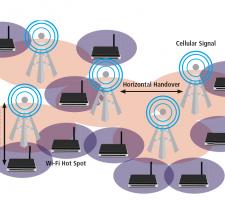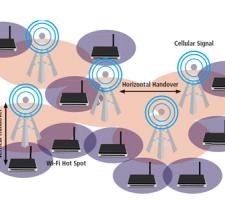
Guidance on the likely impact of multipath communications on connected vehicle development has been published by ITS America.
By 2020 it is predicted that nearly every new US-built vehicle will have embedded, cellular-based telematics along with Wi-Fi to support ‘local area’ connectivity. New vehicles are also increasingly equipped with Dedicated Short Range Communications (DSRC) and the report examines the implications of this this system for time-critical applications such as V2V crash avoidance systems.
In looking at the opportunities, implications and limitations of the various communication technologies, the report also looks at the protocols involved to package, code and decode the data being transmitted and received. In this respect it says vehicles will connect using multiple radio access technologies which rely on conventional networking standards such as Transmission Control Protocol/Internet Protocol (TCP/IP).
While DSRC supports the TCP/IP connections used by more than three quarters of internet traffic, it also supports the specially designed Wireless Access for Vehicular Environments (WAVE) Short Message Protocol (WSMP) for time-sensitive communications.
While Internet Protocol resolves routing between the data source and destination, TCP manages the connection, providing a reliable, ordered and error checked delivery of a stream of data between computers connected to a network.
TCP/IP was not designed for wireless mobile devices changing location or paths in mid-communication as happens when a vehicle moves from one wireless area network to another. Also unforeseen was that a mobile device could be simultaneously connected to several wired or wireless networks which led to the introduction of the Multi-Path TCP standard. There are also ongoing efforts to devise inverse multiplexing - a TCP connection using multiple communication paths.
The report predicts that in the near future most mobile devices will support Multi-Path TCP to aggregate network capacity by combining Wi-Fi and cellular, treating them as one network and allowing them to be used interchangeably on the fly. According to the authors this multinetwork access function and interoperability could be of great benefit to non-safety critical vehicle/road infrastructure mobility applications although security concerns and other constraints still exist.
As currently MultiPath TCP cannot simultaneously authenticate multiple networks (although work is ongoing), the authors Steven Bayless and Adrian Guan say communications over this system must be monitored to reduce vulnerability to cyber attacks.
It is predicted that many devices and networks may soon incorporate wireless inverse multiplexing standards such as MultiPath TCP/IP and the report describes these technologies in some detail, along with some of the technical and operational challenges. If these are overcome, it suggests that widespread adoption of standards such as Multi-Path TCP may influence the evolution of the V2I communications architecture envisaged by the USDOT’s Connected Vehicle program.
Also highlighted in the report is the potential for rapid growth in machine-to-machine (M2M) communications within the vehicle itself where a Wireless Controller Area Networks (WCAN) could be used for systems such as wireless keyless entry or tyre pressure monitoring. WCAN could also be used for control, powertrain and telematics systems to minimise wiring, weight and space requirements while adding redundancy and increasing reliability.
As NHTSA announced its intentions to standardise V2V communications for shortrange crash avoidance applications last year, the report expects the next generation of light vehicles may utilise DSRC to support both V2V and V2I applications. It also predicts that DSRC roadside units (RSUs) may be deployed at 300,000 signalised intersections (and potentially many other locations) across the US to run V2I applications to support traffic safety, mobility and environmental applications.
As NHTSA is to start a rulemaking on the incorporation of DSRC into vehicles, the FHWA is to issue guidance to road operators on the deployment of traffic control and other devices using RSUs.
The report outlines the technology and says vehicles and RSUs could transmit safety-critical application data relevant to the local area and ‘highly current’ events including forward collision and cross traffic warnings. These systems could also be used for traffic control at intersections, traffic lights or tolling gantries (see Diagram 1).
As the authors point out, mobile broadband connections could be used for many infrastructure- and vehicle- oriented services. These including locating unoccupied parking bays, idle taxis or rental vehicles and vacant passenger seats while on the vehicle side services could include remote monitoring (vehicle diagnostics, fleet management and pay-as-you drive insurance).
Also examined are the relative merits of two standards (Multi-Path TCP and the Stream Transmission Control Protocol) for technologies used to aggregate capacity across different radio access link services. While Stream Transmission Control Protocol is said to have failed to gain adherents, Apple’s iOS 7 was first to market using Multi-Path TCP. However the report says there are currently no open interfaces for applications to leverage, although these may soon be available as Android and Linux?based devices are reportedly being tested.
Multi-Path TCP enables a connection from a moving vehicle to operate across multiple paths simultaneously, allowing data segments of one TCP session to flow over multiple paths. These diverse paths are chosen adaptively based on their capacity and consequently maximises throughput in TCP sessions.
The report explains that Multi-Path TCP does not associate a session with a single IP address of a source, so if a source node has additional IP addresses, they are passed to the destination (see Diagram 2).
More importantly from a moving vehicle perspective is that when one of the IP addresses being used becomes unavailable, it is removed and the associated sub-flow is terminated while allowing the session to be preserved.
Currently only cellular communications provide roaming across cells using a single radio access technology (known as ‘horizontal roaming’) although the report says Multi-Path TCP poses the possibility of ‘vertical roaming’, where a user roams across coverage areas using different access technologies. This concept described as ‘Media Independent Handover’ and is a component of the ‘heterogeneous’ networking illustrated in Diagram 3.
Vertical handovers can be done by reducing the data flow on a faltering service and increasing the load on another of the wireless interfaces current being used. Alternatively, if an interface is lost suddenly without warning, Multi-Path TCP can establish a second interface and re-transmit any data lost as a result of the failure of the first interface.
Security and Usability Challenges
The report highlights two security problems that could hold back the promise of Multi-Path TCP: authentication and vulnerability. The technology cannot simultaneously authenticate multiple networks and agile addresses raising security issues which could lead network providers to limit the scale of future Multi?Path TCP adoption on mobile devices.
By exploiting the agile IP address system, the report says several known types of attacks may be launched including ‘flooding’ a network or service with large amounts of traffic in order bring it down to create a Denial of Service.
With Wi?Fi access two different issues are particularly relevant when considering vehicle based communications: most Wi?Fi hotspots are relatively small, and there are more than 150,000 of them across the US. A moving vehicle could therefore enter and leave the coverage of hundreds of Wi-Fi networks in a single journey but currently each requires a manual log-in and that obstacle has yet to be overcome.
The report says work is progressing on these problems with the Institute Electronics and Electrical Engineering’s (IEEE) 802.11u standard which is incorporated into ‘Hotspot 2.0 / Passpoint’. This is a Wi-Fi Alliance certification initiative to provide seamless interoperability allowing mobile users to roam between Wi-Fi networks without additional credentials.
On the down side this still requires a network service operator of one or more roaming consortia to register and maintain users’ credentials.
Even if multiple wireless systems are available, the authors point out that challenges will still remain as Multi-Path TCP and similar protocols cannot help applications ‘choose’ which network path is best. For instance, applications involving public safety or crash avoidance will require high capacity, low latency or extra security. It says critical applications could certainly benefit from transparency in network operations or common services, such as level of performance, capacity, cost and security.
So while technology has created the potential for wireless communications, substantial challenges remain but the report points out that solutions are being developed and the potential benefits to the transportation sector that the technology would enable are substantial.
The entire paper can be














